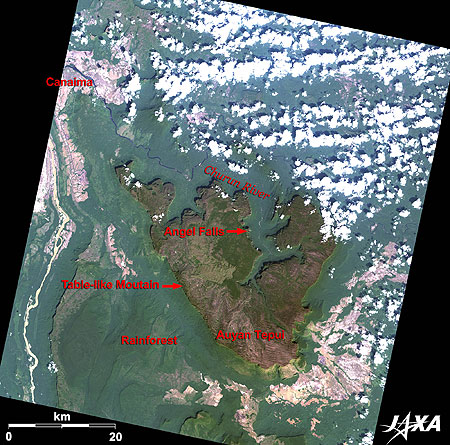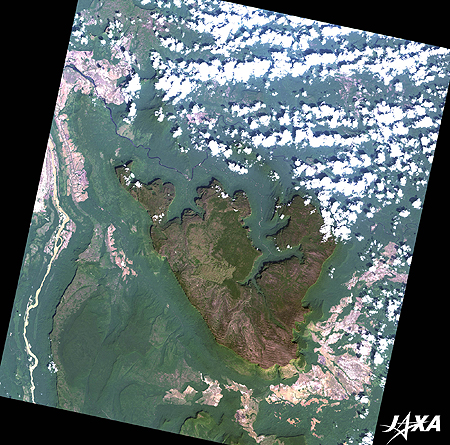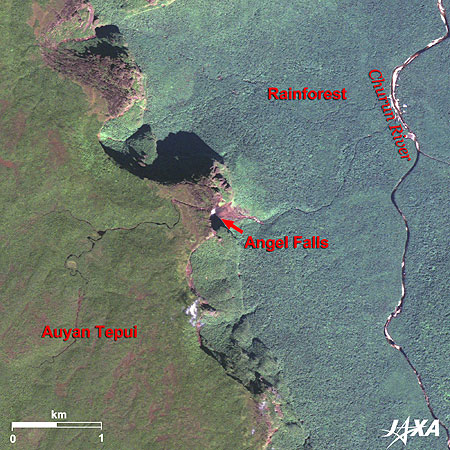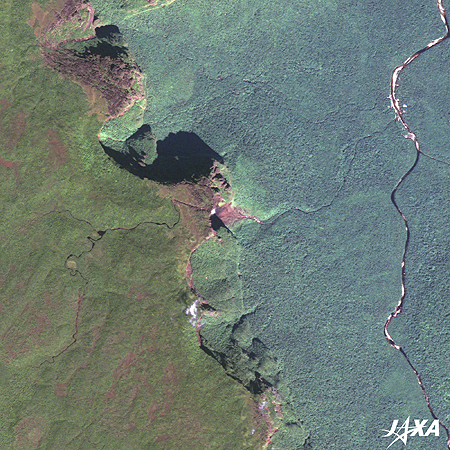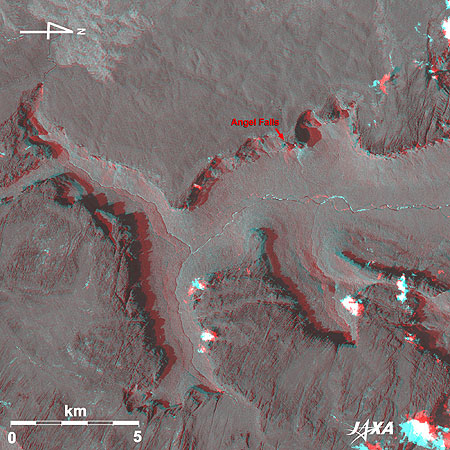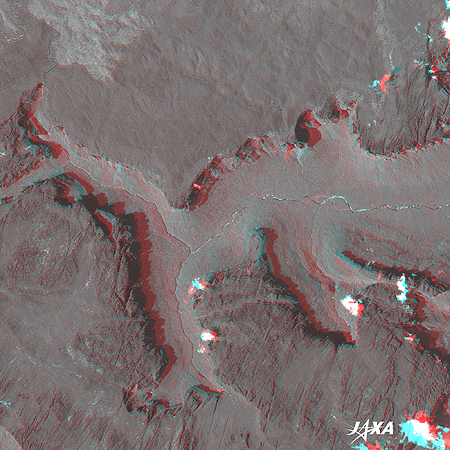

Latest Observation
2010.03.17 Wed
Angel Falls: The World’s Highest Waterfall
Today, when science and technology are deemed highly developed, people may think that mankind’s explorations have reached every corner of the Earth. Nevertheless, there are still hidden places where people can hardly set foot. The Guiana Highlands may be the king of such mysterious places.
Figure 1 depicts Angel Falls and its vicinity as observed by ALOS (“Daichi”) in December 2009. The Guiana Highlands are located in northern South America, extending over Columbia, Venezuela, Guyana, Surinam, French Guiana, and Brazil. More than 100 isolated table-like mountains (mesas) tower above the Amazon rainforest, and cover a total area of about 30,000 km2, which is equivalent to the size of Belgium. The dark green and brown area in the center of the image is one such mesa, called “tepui,” (“House of the Gods”) in the native tongue. These geological features are the remains of the hard rock bed of an ancient large plateau that was eroded by rain, etc., over the course of Earth’s history. The rims of these tepuis are sheer cliffs about 1,000 meters high.
Rocks of the Guiana Highlands are very old, formed about 2 billion years ago. As seen by the many groups of clouds in Figure 1, the rainfall of this area is also world class. Annual precipitation exceeds 4,000 millimeters.
Because of their ancient isolation from the forest floor, an entirely unique ecosystem has evolved on the mesa tops, with various endemic species of plants, insects, and animals, including those still undiscovered. Sir Arthur Conan Doyle, author of the Sherlock Holmes books, was inspired by the mysterious Guiana Highlands and novelized The Lost World, a story in which dinosaurs survived on the highland. Those outstanding figures of table-like mountains make it easy for us to believe that such imagination could be real.
Water falls in abundance from the rim of the mesas to the ground below. Angel Falls is the highest among them and is located at the table-like mountain called Auyantepui in Venezuela. With a circumference of 700 km, Auyantepui is the largest table-like mountain in the Guiana Highland and as large as the Tokyo metropolitan area in Japan. Such a clear image of Auyantepui and Angel Falls is very rare since this area is cloudy most of the time. Canaima National Park, which includes Angel Falls, was added to the World Heritage of UNESCO in 1994.
caption on
caption off
Fig. 2. Enlarged Image of Angel Falls
Angel Falls (kmz, 4.36 MB, High Resolution) as seen on Google Earth
Angel Falls is the highest (978 meters) and most spectacular waterfall in the world with an uninterrupted descent of 800 meters. Figure 2 clearly show the white plume of the waterfall. If you listen closely, you may even hear the roaring sound. However, it has no basin because the height of the falls is so great that much of the water evaporates or is carried away as a fine mist before reaching the bottom.
caption on
caption off
Fig. 3. Three-Dimensional View of Angel Falls
(Staring at the image for a long time may cause eye-strain. A color print is available in PDF. PDF files for the left and right eyes are also available for stereoscopic viewing.)
The table-like mountain and Angel Falls can be enjoyed in 3D if viewed with a blue glass over the right eye and a red glass over the left eye. The difference of heights between the top of the table-like mountain and the valley, and dissipating water during the fall might also be recognized. Note that upward is north in Fig. 1 and 2, whereas the right hand side is north in Fig. 3, a result of the flight direction of the satellite.
Mr. Angel Found the World’s Highest Waterfall at “Devil’s Mountain”
In its indigenous language, Auyantepui means “Devil’s Mountain.” It is not hard to imagine that this mountain, mostly hidden in the clouds, is a sacred place for the indigenous people. The opposing names Angel Falls and Devil’s Mountain are interesting, but the falls are simply named after their discoverer.
In 1937, American explorer Jimmie (James) Angel and his companions found this great waterfall when they flew over the mountain searching for a gold ore bed. They landed atop Auyantepui but the airplane was damaged in the marshy ground and was unable to take off. They were forced to descend the tepui on foot and after 11 days of hard walking returned to civilization. The news of their adventure spread and Angel Falls became known worldwide.
President of Venezuela Claims “Angel Falls” To Be Renamed
A small ripple involving the name of Angel Falls spread around the world in January 2010 when President Hugo Chavez of Venezuela claimed that Angel Falls should be renamed. President Chavez is known as a radical leftist, and is appealing for the building of “Socialism of the 21st century.” After his assumption to power in 1999, the name of the country was changed from “The Republic of Venezuela” to “The Bolivarian Republic of Venezuela.” According to The Guardian, he was reported to have said: “This is ours, long before Angel ever arrived there… this is indigenous property,” and insisted on changing the name to “Kerepakupai Meru,” which in the indigenous language means “Waterfall of the Deepest Place.”
Regardless of what people call it, the world’s greatest waterfall has been dropping water in its inaccessible hidden location since the dawn of time.
Explanation of the Images:

| Satellite: | Advanced Land Observing Satellite (ALOS) (Daichi) |
| Sensor: |
Advanced Visible and Near Infrared Radiometer-2 (AVNIR-2) and Panchromatic Remote-sensing Instrument for Stereo Mapping (PRISM) |
| Date: | 1445 (UTC) on December 31, 2009 (Simultaneous observation of AVNIR-2 and PRISM) |
| Ground resolution: | 10 m (AVNIR-2) and 2.5 m (PRISM) |
| Map Projection: | Universal Transversal Mercator (UTM) |
AVNIR-2 has four observation bands. The composite images are usually produced by assigning red to Band 3 (610 to 690 nm), green to Band 2 (520 to 600 nm), and blue to Band 1 (420 to 500 nm). The resulting images have natural coloring as if seen by the naked eye. Thus, the following colors designate ground objects:
| Dark Green: | Forests |
| Light Green: | Jungles |
| Brown: | Rocky stretch |
| White: | Clouds |
PRISM is an optical sensor for observing ground surfaces with visible and near-infrared signals in the 520- to 770-nanometer (one-billionth of a meter) band. The acquired image is monochrome. PRISM has three independent optical systems (telescopes) to acquire images for nadir, forward, and backward views simultaneously. Only the nadir image was used in this article.
The above AVNIR-2 composite image was then transformed into hue, saturation, and intensity, and the intensity was replaced by the PRISM image. The hue, saturation, and intensity data were then reversed into a color image. As a result, a virtual 2.5-m ground-resolution color image was obtained. This kind of high-resolution color image, composed by combining the higher resolution monochrome image and the lower resolution color image, is called a pan-sharpened image. Figure 2 is a high-resolution, pan-sharpened image composed this way.
Figure 3 combines nadir (red) and forward (green and blue) images of PRISM. The left eye sees the nadir image, and the right eye sees forward image, which means the left side corresponds to the satellite flight direction pointing south.
The World’s Great Falls (Part 1) Iridescent Niagara Falls between USA and Canada
The World’s Great Falls (Part 2) Victoria Falls Falling into a Chasm between Zambia and Zimbabwe
The World’s Great Falls (Part 3) Iguazu Falls: A Thundering Roar of the Earth between Argentina and Brazil
Search by Year
Search by Categories
Tags
-
#Earthquake
-
#Land
-
#Satellite Data
-
#Aerosol
-
#Public Health
-
#GCOM-C
-
#Sea
-
#Atmosphere
-
#Ice
-
#Today's Earth
-
#Flood
-
#Water Cycle
-
#AW3D
-
#G-Portal
-
#EarthCARE
-
#Volcano
-
#Agriculture
-
#Himawari
-
#GHG
-
#GPM
-
#GOSAT
-
#Simulation
-
#GCOM-W
-
#Drought
-
#Fire
-
#Forest
-
#Cooperation
-
#Precipitation
-
#Typhoon
-
#DPR
-
#NEXRA
-
#ALOS
-
#GSMaP
-
#Climate Change
-
#Carbon Cycle
-
#API
-
#Humanities Sociology
-
#AMSR
-
#Land Use Land Cover
-
#Environmental issues
-
#Quick Report
Related Resources
Related Tags
Latest Observation Related Articles
-
 Latest Observation 2025.10.01 Wed [Quick Report] Hurricane Humberto “Eye” captured by EarthCARE satellite (Hakuryu)
Latest Observation 2025.10.01 Wed [Quick Report] Hurricane Humberto “Eye” captured by EarthCARE satellite (Hakuryu) -
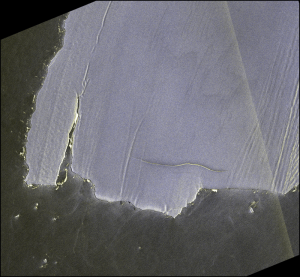 Latest Observation 2025.02.28 Fri The world’s largest iceberg, A23a, may have run aground on the continental shelf of South Georgia:
Latest Observation 2025.02.28 Fri The world’s largest iceberg, A23a, may have run aground on the continental shelf of South Georgia:
The trajectory of iceberg A23a observed by “GCOM-W”, “ALOS-2” and “ALOS-4” -
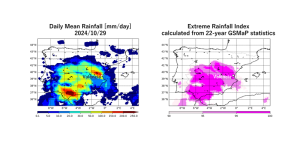 Latest Observation 2024.11.06 Wed [Quick Report] Heavy rainfalls in eastern Spain, as seen by the Global Satellite Mapping of Precipitation (GSMaP)
Latest Observation 2024.11.06 Wed [Quick Report] Heavy rainfalls in eastern Spain, as seen by the Global Satellite Mapping of Precipitation (GSMaP) -
 Latest Observation 2024.10.11 Fri Antarctic Winter Sea Ice Extent Second lowest in Satellite History
Latest Observation 2024.10.11 Fri Antarctic Winter Sea Ice Extent Second lowest in Satellite History










